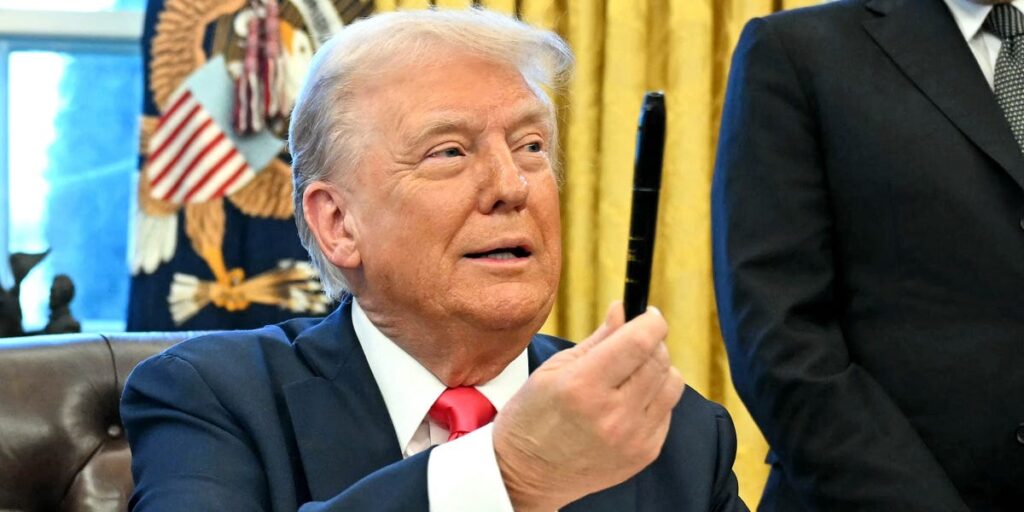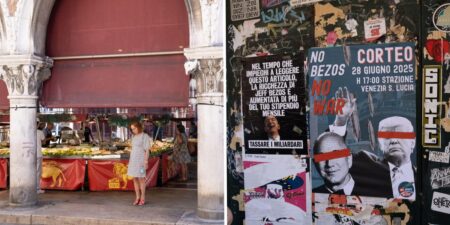President Donald Trump is running out of time to cut trade deals before the 90-day pause on his so-called reciprocal tariffs could come back into effect.
Trump said on May 6 that he’s not in a rush to sign a deal. In previous weeks, the president had said that trade deals could be announced soon, only for nothing to happen.
“Everyone says, ‘When, when, when are you going to sign deals?’ We don’t have to sign deals. We could sign 25 deals right now, Howard, if we wanted,” Trump said on Tuesday in the Oval Office, motioning to Commerce Secretary Howard Lutnick. “We don’t have to sign deals. They have to sign deals with us. They want a piece of our market. We don’t want a piece of their market, we don’t care about their market.”
Wall Street continues to hang on every word. There’s even evidence that traders grow more nervous when Trump’s more protectionist advisors are the news.
Here’s what we know about where discussions stand for major US partners.
China
The US and China can’t agree on who initiated discussions, but it is significant progress that the world’s two largest economies are talking.
Treasury Secretary Scott Bessent has said that a deal with China is more complex, so the Trump administration views it as separate from discussions with roughly 17 other nations.
Beijing has publicly boasted that it can endure a protracted trade fight. Trump has previously said that discussions had occurred, but Beijing denied this.
A breakthrough could be coming. On May 6, Bessent said that he and US Trade Representative Jamieson Greer will travel to Switzerland for face-to-face talks with He Lifeng, China’s top economic official.
Beijing said that the Swiss government invited He. The talks will occur in the same city where the World Trade Organization is headquartered.
Trump has long complained about China’s 2001 admission to the WTO.
Canada
Trump met with the newly elected Canadian Prime Minister Mark Carney on May 6 in the Oval Office.
Carney told reporters that Canadian officials and the two leaders will follow up on trade discussions from the Oval Office meeting “in the coming weeks.”
During a public portion of their meeting, Trump and Carney both said that there need to be changes made to the US-Mexico-Canada agreement, Trump’s first-term rewrite of the North American Free Trade Agreement.
In the meantime, the US continues to impose a 25% tariff on non-USMCA-compliant Canadian goods and a 10% tariff on energy imported from Canada. Additional US tariffs on automobiles, steel, and aluminum also apply to Canadian goods.
Canada retaliated by imposing a 25% tariff on US goods, including steel, aluminum, and agricultural goods.
India
Vice President JD Vance said on May 1 that a US-India trade deal would “be among the first deals” the administration will reach.
“Pretty soon,” Vance told Fox News anchor Bret Baier.
Vance traveled to India for a four-day trip in April, spending significant time with Indian Prime Minister Narendra Modi.
Trump imposed a 27% tariff on Indian goods as part of his “Liberation Day” announcement. His 90-day pause on those tariffs ends on July 9. As a large purchaser of Venezuelan oil, India could also face additional US tariffs.
Vietnam
Vietnam’s top trade negotiator Nguyen Hong Dien on May 7 urged his country’s businesses to be “proactive” in doing more business with the US.
Greer, according to a Bloomberg News report, told Dien during a March meeting in Washington that Vietnam needed to do more to lower the US trade deficit. The US deficit was $123.5 billion in 2024, an 18% increase from the previous year.
Trump imposed a 46% tariff on Vietnam as part of his “Liberation Day” announcement — it, too, is subject to the 90-day pause.
European Union
European Trade Commissioner Maros Sefcovic said on May 6 that the European Union will release more details about potential countermeasures should talks with Trump fail.
“Negotiations clearly come first but not at any cost,” Sefcovic told reporters, per NBC News.
In April, Italian Prime Minister Giorgia Meloni became the first European leader to visit Washington after Trump roiled global markets with his “Liberation Day” tariffs. At the time, both she and Trump spoke positively of a potential deal.
Japan
Trump said on April 30 that he had “potential deals” with Japan, India, and South Korea.
Ryosei Akazawa, Japan’s chief negotiator, told reporters a few days later that he and his US counterparts had “concrete discussions.”
“There are still many issues that need to be addressed and resolved before a final agreement can be reached,” Akazawa said.
Trump imposed a 24% tariff on Japanese goods before announcing his 90-day pause.
South Korea
South Korea sent representatives to the US early on, but it’s unlikely to be one of the first countries to strike a deal.
That’s because South Korea is holding snap elections on June 3. A senior government official previously told Reuters that no deal would come before the election.
Read the full article here
















